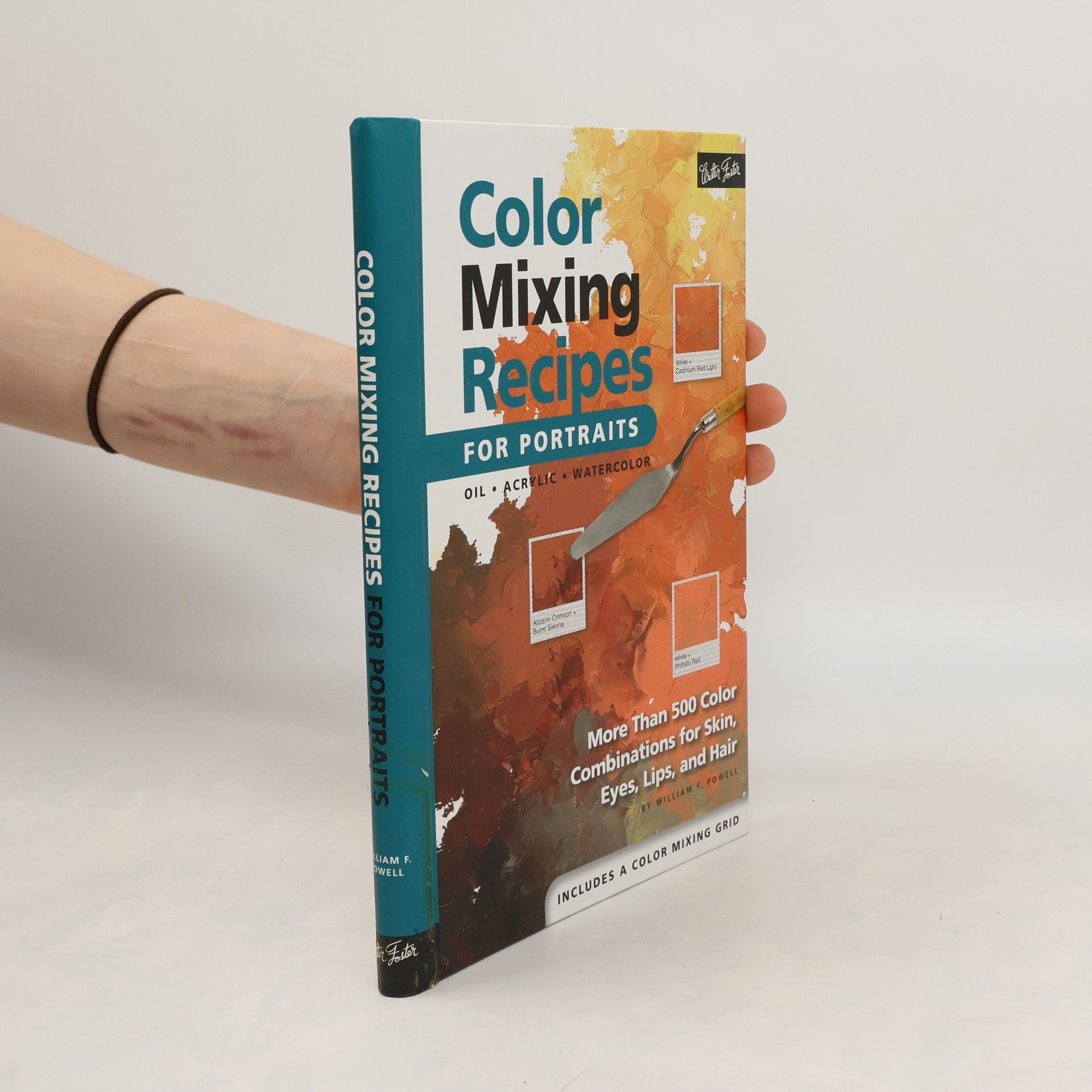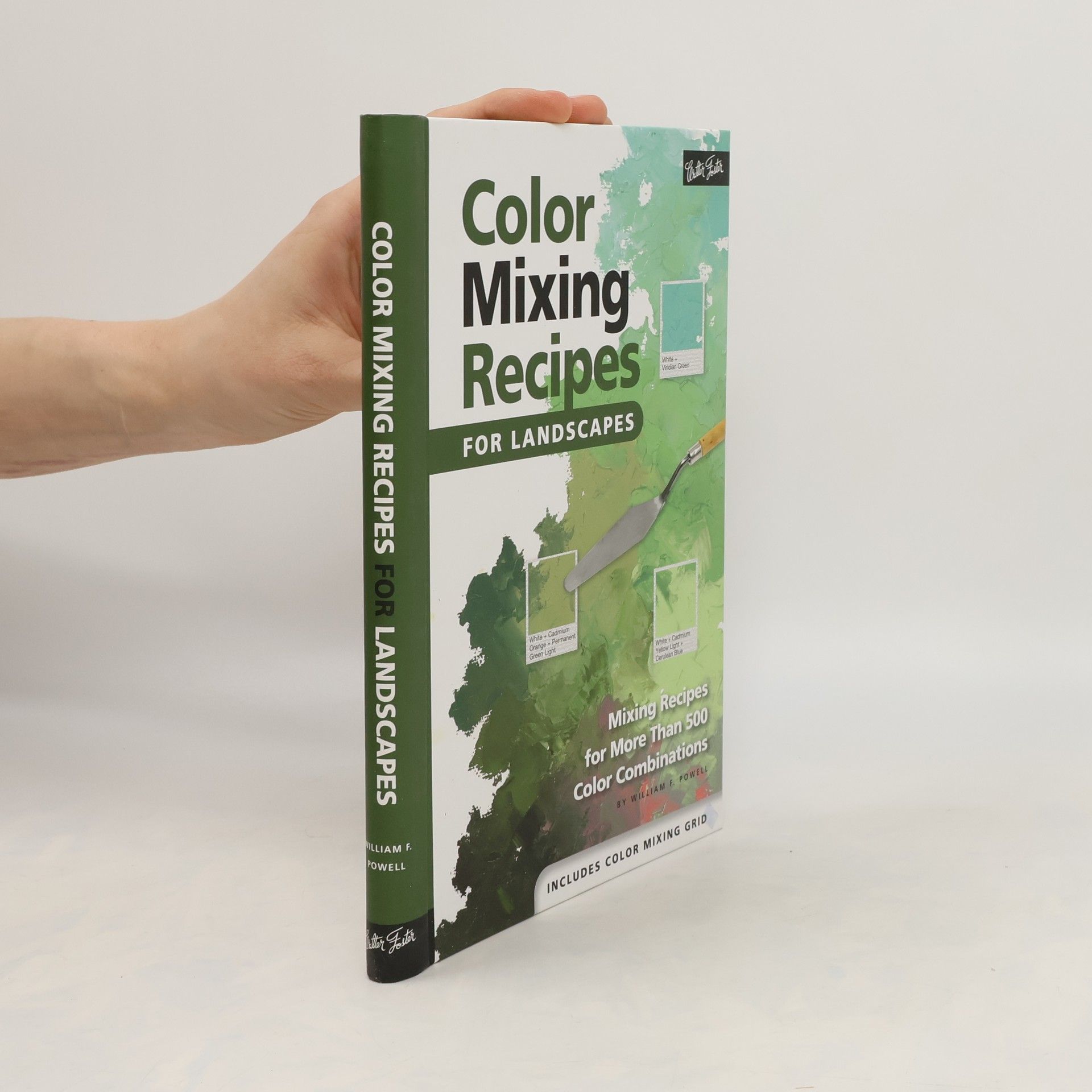In the latest addition to the Color Mixing Recipes family of books, artist William F. Powell provides instruction on color mixing as it relates to landscape painting in oil and acrylic. Following the format of the other books in the series, Color Mixing Recipes for Landscapes offers a robust index of landscape subjects that correspond to the featured color mixing swatches. This useful book also discusses how color is influenced by the time of day, the angle of the sun, and changing seasons, making it a must-have in every oil and acrylic artist's reference library.
William F. Powell Knihy
William F. Powell je uznávaný umělec a jeden z nejvýznamnějších amerických koloristů. Je autorem a ilustrátorem více než 30 výukových knih o umění, které čtenářům přibližují jeho mistrovství v práci s barvou. Jeho díla jsou ceněna pro svou vizuální hloubku a schopnost inspirovat další tvůrce. Prostřednictvím svých publikací sdílí Powell své bohaté zkušenosti a uměleckou filozofii, čímž obohacuje výtvarnou komunitu.






Drawing: Flowers with William F. Powell
- 40 stránek
- 2 hodiny čtení
Learn to create detailed, realistic flowers in graphite pencil from basic shapes. Drawing: Flowers shows you how to render a variety of beautiful flowers in graphite pencil, with tips on choosing materials, building with basic shapes, and shading to develop form and realism. With a wealth of detailed step-by-step projects to both recreate and admire, William F. Powell teaches artists how to develop a drawing to its fullest, no matter the subject. Among the flowers you'll learn to draw: Regal Lily Daffodil Carnation Hibiscus Peony Chrysanthemums Bearded Iris Designed for beginners, the How to Draw & Paint series offers an easy-to-follow guide that introduces artists to basic tools and materials and includes simple step-by-step lessons for a variety of projects suitable for the aspiring artist. Drawing: Flowers allows artists to develop their drawing skills, demonstrating how to start with basic shapes and use pencil and shading techniques to create varied textures, values, and details for a realistic, completed drawing.
Learn to mix virtually any skin tone in oil, acrylic, and watercolor paints with the recipes and acrylic mixing grid in Color Mixing Recipes for Portraits Oil - Acrylic - Watercolor.
1,500 Color Mixing Recipes for Oil, Acrylic & Watercolor is the definitive color-mixing resource for oil, acrylic, and watercolor artists. This user-friendly compendium is color coded for quick-and-easy reference and includes two removable color-mixing grids--one for oil or acrylic, and one for watercolor. Follow these four simple steps to mix more than 1,500 color combinations: Look in the Color Guidance Index for the subject you want to paint--for example, "Broccoli." Find the Color Recipe with the subject's recipe number ("81") and a photo of the actual paint mixture. Use the Color Mixing Grid to measure each paint color. Mix the color. It's that easy! You'll also learn about color theory, mixing values, complementary colors, graying color naturally, mixing portrait colors, rendering skies and clouds, and more. Also available from Walter Foster's best-selling Color Mixing Recipes series: Color Mixing Recipes for Oil & Acrylic, Color Mixing Recipes for Watercolor, Color Mixing Recipes for Portraits, and Color Mixing Recipes for Landscapes.
Color Mixing Recipes for Portraits
- 48 stránek
- 2 hodiny čtení
Color Mixing Recipes for Portraits features master mixes for an array of skin colors in oil, acrylic, and watercolor—plus recipes for hair, eye, and lip colors. The concealed wire-o bound book also includes a plastic color-mixing grid for measuring out paints, as well as a handy conversion chart for finding acrylic equivalents of oil paints and vice versa. With recipes for more than 500 color combinations, this comprehensive guide is your ultimate source for painting realistic skin, mouths, ears, noses, eyes, and hair.This convenient guide details three simple steps to mix virtually any skin tone : Also With recipes for more than 500 color combinations , Color Mixing Recipes for Portraits is your ultimate source for painting realistic skin, mouths, ears, noses, eyes, and hair.
Drawing: Landscapes with William F. Powell
- 40 stránek
- 2 hodiny čtení
William F. Powell invites you into his artistic world to explore a number of basic drawing techniques and shows how to develop a drawing to its fullest through a series of step-by-step demonstrations. In Landscapes, he explains a number of drawing techniques and special effects and gives tips on how to design a well-balanced composition. Landscapes provides you with the necessary knowledge to create your own landscape drawings from preliminary sketch to the completed work. Discover different methods of shading, ways of manipulating drawing tools to produce specific textures, and a wealth of beautiful landscapes to both copy and admire. Also included are simple techniques for developing common landscape elements-such as trees, clouds, rocks, and water-and how to apply a variety of methods to convey a sense of realism. Then, with a little practice, you will be able to apply your newfound skills and draw your own beautiful landscape masterpieces!
Color Mixing Recipes for Watercolor is the definitive color-mixing resource for watercolor artists. With a wide spectrum of paint recipes, each revealing the color proportions and dilution level needed to achieve the featured swatch, this user-friendly book also includes a color-mixing grid that makes measuring simple. Follow these four simple steps to mix more than 450 color combinations: Look in the Color Guidance Index for the subject you want to paint--for example, "Eucalyptus Bark." Find the Color Recipe with the subject's recipe number ("293") and an example of the actual paint mixture. Use the Color Mixing Grid to measure each paint color. Mix the color. It's that easy! You'll also learn about color theory, mixingvalues, graying color naturally, mixing portrait colors, and more. Also available from Walter Foster's best-selling Color Mixing Recipes series: 1,500 Color Mixing Recipes for Oil, Acrylic & Watercolor; Color Mixing Recipes for Oil & Acrylic; Color Mixing Recipes for Portraits; and Color Mixing Recipes for Landscapes.
The Art of Basic Drawing
- 128 stránek
- 5 hodin čtení
Filled with easy step-by-step instruction from a variety of artists and a wealth of inspiring images to study and admire, The Art of Basic Drawing shows beginning artists how to draw everything from flowers and still lifes to landscapes, animals, and people. You'll find plenty of helpful tips on choosing the right tools and materials, fundamental drawing techniques, developing value and shading, and setting up an effective composition, as well as important information about the influences of perspective, balance, and texture. Detailed examples of animals, people, flowers, and landscapes will help guide you through the most challenging aspects of drawing almost anything, from basic shapes to realistic details
The Anarchist Cookbook will shock, it will disturb, it will provoke. It places in historical perspective an era when "Turn on, Burn down, Blow up" are revolutionary slogans of the day. Says the author" "This book... is not written for the members of fringe political groups, such as the Weatherman, or The Minutemen. Those radical groups don't need this book. They already know everything that's in here. If the real people of America, the silent majority, are going to survive, they must educate themselves. That is the purpose of this book." In what the author considers a survival guide, there is explicit information on the uses and effects of drugs, ranging from pot to heroin to peanuts. There i detailed advice concerning electronics, sabotage, and surveillance, with data on everything from bugs to scramblers. There is a comprehensive chapter on natural, non-lethal, and lethal weapons, running the gamut from cattle prods to sub-machine guns to bows and arrows. The section on explosives and booby traps ranges from TNT to whistle traps. One hundred and eleven drawings supplement the recipes. "This book is for anarchists," says William Powell, "Those who feel able to discipline themselves on all the subjects from drugs, to weapons, to explosives) that are currently illegal in this country." Techniques, disciplines, precautions, and warnings pervade what may be the most disquieting "how-to" book of contemporary times.
The definitive color-mixing resource for oil and acrylic artists, Color Mixing Recipes for Oil & Acrylic includes color mixing charts that list each color needed to create a combination and painting instructions in a handy, portable size. Follow these four simple steps to mix more than 450 color combinations: Look in the Color Guidance Index for the subject you want to paint--for example, "Sunflower Yellow." Find the Color Recipe with the subject's recipe number ("8") and a photo of the actual paint mixture. Use the Color Mixing Grid to measure each paint color. Mix the color. It's that easy! You'll also learn about color theory, color value mixing, complementary colors, graying color naturally, and mixingportrait colors. Walter Foster's best-selling Color Mixing Recipes series also includes Color Mixing Recipes for Watercolor, Color Mixing Recipes for Portraits, and Color Mixing Recipes for Landscapes. These books contain hundreds of precise color mixing combinations for realistic results, as well as two acetate grids for measuring paint units.